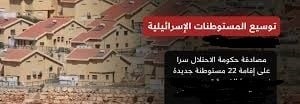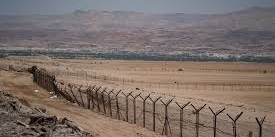By: Madeeha Al-A’raj
The National Bureau for defending land and resisting settlements ( nbprs ) stated in its latest weekly report , that Israeli Occupation Army’s cooperation with the ‘Jewish National Fund’ and other arms of the occupation and settlement is not new. It also seems clear that the Israeli Ministry of the Occupation Army encourages recruits the ‘the Israeli Keren Kemet’ i.e. (the Jewish National Fund) for real estate to purchase deals And large areas of private Palestinian-owned land in the West Bank for the benefit of settlers to be cultivated as soon as the owners are prevented from accessing them, and robbery deals on Palestinian property, which are carried out with cover and facilities from the occupation army, knowing that the the robbery included lands in the Jordan Valley, Ramallah and Hebron. In early April, the fund approved a draft to purchase lands in isolated settlements, especially in the Nablus and Jenin Governorates.
At the same time, the Israeli government is pushing to implement a plan to establish 3,412 settlement units within the settlement plan known as ‘E1’ east of the occupied East Jerusalem, as it was recently revealed that the so-called Israeli Higher Planning Council sent a summons for a hearing on August 9th to discuss the objections submitted by the ‘Peace Now Movement’ AND “Ir Amim” On the plan. This plan is considered completely destructive to the so-called two-state solution because it prevents communication between Ramallah, East Jerusalem and Bethlehem.” It is known that there have been attempts to promote the plan since the 90s, but due to international opposition it was not promoted until Netanyahu ordered its approval for deposit in the year 2012, and he re-promoted it again on February 2020’s elections.
In reference to the occupation’s settlement plans, the so-called “settlement Bloc Council” in the Gush Etzion settlement complex issued a decision to build hundreds of settlement units on lands in Bethlehem. It approved a plan to build 510 settlement units, 400 of them in the “Migdal Oz” settlement built on the land of Beit Fajjar in the south, and 110 units in the settlement of “Abu Hanahel”, which is located on the lands of the town of Kisan in the east. At the same time, the so-called Israeli Civil Administration decided to turn hundreds of agricultural dunums into nature reserves in the Jordan Valley, lands located within the borders of Al-Farisiyah and Ain Al-Hilweh in the Jordan Valley. Information indicates that more than 1,500 dunams of these lands, located in the vicinity of the “Rotem” settlement, have been converted into nature reserves, bringing the number of lands that have been converted by the occupation government in the Jordan Valley into nature reserves so far, 76,000 thousand dunums.” The lands are Palestinian citizens who have all the necessary identification papers on their lands.
Meanwhile, the so-called Israeli Civil Administration began surveying the lands on which the outpost of Avitar is built on Jabal Sbeih, near the town of Beita, south of Nablus. This step comes to implement an agreement signed between the Israeli government and the Regional Council of “Samaria” settlements about 10 days ago, with the aim of surveying the land in preparation for the resumption of the settlement plan and the establishment of a religious school. On the other hand, settler websites reported that Israeli businessman Rami Levy, with the participation of dozens of people, laid last weekend the foundation stone for a new Jewish neighborhood in East Jerusalem. According to those sources, Levi plans to build 400 housing units, two hotels, a large commercial center, public buildings and a huge sports center, next to what is known as the Commissioner’s Palace Park in the heart of the Jerusalem neighborhood of Jabal Mukaber. Noting that about 90 housing units were built last year in Nof Zion.
In Jerusalem, the mayor of the occupation, Moshe Leon, inaugurated the southern section of the (Eastern Ring Project), the American Road, which confiscates hundreds of dunums of lands, tears the neighborhoods and villages of Jerusalem, and links settlements north of the city to its south within the so-called ‘Greater Jerusalem.’ It will serve as the main transportation road in the east of the city. The total length of the road linking Wadi Al-Dara is about 10 km. The total financial investment in the project is NIS 1.3 billion, and this is one Among several projects aimed at disintegrating Jerusalemite neighborhoods and Palestinian villages and exploiting lands for the benefit of settlements and major bypass roads that have been implemented and planned in East Jerusalem. The purpose of it is to link Ma’ale Adumim Settlement with the settlements of the south, limit the Jerusalemites presence between settlements and bypass roads, and devour the remaining lands to prevent their owners from expansion and construction since the announcement of the American road project, 1,070 dunums of lands.
List of Israeli Assaults over the Last Week Documented by the National Bureau:
Jerusalem:
- Forcing Jamal Ajaj to demolish his home in the Al-Sala’a Neighborhood in the Jabal Mukaber town, and forcing Ezzat Ziada to demolish home too, located near the “Gilo” settlement, southeast of Jerusalem.
- Giving Mohammad Nassar Abu Ahmad, from the town of Silwan, 2 days to demolish his home or fine him the costs of the demolition.
- Demolishing sheep barracks or sheep in the Nabi Samuel village. Breaking into a two-room house and a plot of land of more than 250 m2 in Wadi Hilweh Neighborhood in the Silwan town.
Hebron:
- Wounding a 14-year-old child Issa Awad, in the village of Al-Tuba, Masafer Yatta, as a result of being stoned by settlers from “Ma’on and Khafat Ma’on” settlements, under the protection of the occupation soldiers, south of Hebron.
- Organizing a march on the Al-Zahiriyah crossing ‘Mitar’ south of Hebron, and closing the road in both directions.
- Seizing a caravan, east of Yatta, south of Hebron.
- Demolishing a stone retaining wall in the town of Bani Naim, east of Hebron, with a length of 200 meters and a height of approximately 6 meters at the entrance to the town.
Ramallah:
- Demolishing 11 homes and tents in the Bedouin community of “Al-Quboun” located near the villages of Kafr Malik and Al-Mughir, northeast of Ramallah, and the confiscation of property, including agricultural tractors, water tankers and solar energy units.
Nablus:
- Demolishing amain electricity poles in the network that feeds Khirbet Surra on the western side of the village of Jalud.
- Storming the town of Awarta, southeast of Nablus, under the pretext of performing Talmudic rituals in its historical shrines.
- Settlers attacked a house on the outskirts of Burin village, south of Nablus, and wreaked havoc in it.
- Wounding Mamoun Nassar, 49, from Madama village by a live bullet in the leg.
- Cutting 150 olive trees from the lands of Burin, south of Nablus, and seizing a bulldozer that was working on lands belonging to Furush Beit Dajan and Ein Shibli, east of Nablus.
- Storming the archaeological area of Al-Hafriya in Wadi Al-Far’a, south of Tubas, under the protection of the occupation forces, and they performed Talmudic rituals.
Salfeet:
- Demolishing 4 commercial facilities belonging to Hassan Saleh Kulaib from the Haris town, an aluminum shop, a car wash, and a car repair facility under the pretext that they are located in Area C.
Jordan Valley:
- Bulldozing lands of the citizens near the village of Ein al-Bayda in the northern Jordan Valley, noting that the lands were owned by the Tabu papers” of Palestinian citizens.
- Demolishing a 250-cube water pool for agricultural use near Bardala village in the northern Jordan Valley, owned by Samer Hosni Sawafta, provided by the Ministry of Agriculture.
- dismantling of a 60-square-meter residential tent in Khirbet Humsa, in the northern Jordan Valley, owned by Walid Suleiman Abu Kabash.
 المكتب الوطني للدفاع عن الارض ومقاومة الاستيطان منظمة التحرير الفلسطينية
المكتب الوطني للدفاع عن الارض ومقاومة الاستيطان منظمة التحرير الفلسطينية




